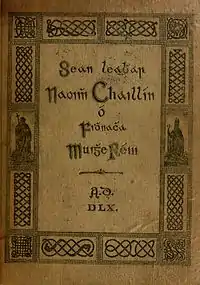Book of Fenagh
The Book of Fenagh (Irish: Leabar Fidhnacha) is a manuscript of prose and poetry written in Classical Irish by Muirgheas mac Pháidín Ó Maolconaire in the monastery at Fenagh, West Breifne (modern-day County Leitrim).[1] It was commissioned by Tadhg Ó Rodaighe, the coarb of the monastery, and is believed to derive from the "old Book of Caillín" (Irish: Leabar Chaillín), a lost work about Caillín, founder of the monastery.[1] Ó Maolconaire began work about 1516.[1]

Provenance

The O'Roddy coarbs and descendants retained the book down to Brian O'Roddy, parish priest of Kilronan (Ballyfarnon) in the mid-19th century, upon whose death it was retained by his successors as parish priest.[2] It later passed to George Michael Conroy, Bishop of Ardagh and Clonmacnoise, for safe-keeping, before his successor Bartholomew Woodlock sold it in 1888 to the Royal Irish Academy (RIA) for £10.[3] This was on the advice of Denis Murphy, a Jesuit, that the RIA were best able to preserve it.[3][4] Its catalogue number is RIA MS 23 P 26: Cat. No. 479.[1]
John O'Donovan made a facsimile transcript in 1828, and a manuscript English translation in 1830.[5] The first published edition was in 1875, edited by William Maunsell Hennessy and translated by Denis H. Kelly from O'Donovan's facsimile.[5] The Irish Manuscripts Commission published a supplementary volume in 1939 with material missing from previous versions.
Contents
| [4] | ||
| Part | Form | Subject |
|---|---|---|
| 1A | Prose | Introduction and Genealogy of St. Caillín |
| 1B | Poetry | 14 poems about Caillín, Magh Rein (south County Leitrim), and the Bell of Fenagh (Clog Na Riogh, "the bell of the kings", now in St Mel's Cathedral[6]). |
| 1C | Prose | Introductions to Poems |
| 2A | Prose | Caillín and Tadhg O'Roddy |
| 2B | Prose | Ó Maolconaire discusses the Old Book of Caillín |
| 3 | Poetry | The O'Donnells and other families |
| 4 | Prose | Genealogies of Conmaicne, O'Crechan (probably of Conmhaícne Dúna Móir[7]), and the Abbot of Fenagh |
| 5 | Poetry | Six poems: five on the O'Neills and other families, and one on Caillín |
Marginal notes in Irish adorning the book are commentaries by the noted Irish antiquarian Tadhg O'Rodaighe (floruit 1700) from Crossfield in Fenagh. The book was used as a source for the Annals of Connacht and the Annals of the Four Masters.[5]
Cumdach

A metal cumdach (a book-shaped shrine) known as the "Shrine of Caillín" was built before 1536 to hold and protect the manuscript.[8][9] Caillín is described by Lucas as "something of a specialist in the production of battle talismans"[10] and according to legend, in his lifetime commissioned a number of battle standards, including this shrine.[10] The shrine was badly damaged in a 2009 fire at St Mel's Cathedral, Longford, where it had been kept since 1980.[8] It was acquired by the National Museum of Ireland the following year, while the manuscript is in the collection of the Royal Irish Academy.[11] There is some doubt as to if the shrine was actually intended as a cumdach, given that it is smaller than the manuscript.[8]
References
- "Book of Fenagh". Royal Irish Academy. 31 August 2015.
- Hennessy 1875, p.ix
- Cunningham, Bernadette (15 June 2016). "Celebrating 500 years of the Book of Fenagh". Royal Irish Academy. Retrieved 19 May 2017.
- "Book of Fenagh history". fenagh.com. Fenagh Visitors Centre. Archived from the original on 12 March 2019. Retrieved 18 August 2016.
- RIA 2016
- "The Bell of Fenagh". Fenagh Visitors Centre. Archived from the original on 12 March 2019. Retrieved 19 May 2017.
- Hennessy, in: Ó Maolconaire 1875, p.383 fn.13
- Scott (2017), p. 20
- "The shrine of St Caillín of Fenagh and its place in Irish late medieval art". Royal Irish Academy, 2016. Retrieved 10 August 2022
- Lucas (1986), p. 19
- Scott (2017), pp. 18, 20
Sources
- "Book of Fenagh 500th anniversary". Royal Irish Academy. 2016. Archived from the original on 14 January 2020. Retrieved 19 May 2017.
- Lucas, Anthony. "The Social Role of Relics and Reliquaries in Ancient Ireland". The Journal of the Royal Society of Antiquaries of Ireland, volume 116, 1986. JSTOR 25508904
- Ó Maolconaire, Muirgheas mac Pháidín (1875). Hennessy, W. M. (ed.). "The Book of Fenagh in Irish and English". Translated by Kelly, D. H. Dublin: Alexander Thom. Retrieved 19 May 2017. (Another digitisation from National Library of Scotland)
- Macalister, R. A. S., ed. (1939). The Book of Fenagh: supplementary volume. Irish Manuscripts Commission. Retrieved 19 May 2017.
- Scott, Brendan. "The Making of the Book of Fenagh". History Ireland, volume 25, no. 3, 2017. JSTOR 90014529
Further reading
- O Rodaighe, Tadhg. "Tadhg O Rodaighe to [Edward Lhwyd], [around May 1700]" (PDF). Oxford University Research Archive. Archived from the original (PDF) on 6 October 2016. Retrieved 31 August 2016.
External links
- Book of Fenagh / Leabar Chaillín / Leabar Fidhnacha Royal Irish Academy; links to digital images of the manuscript
- The Book of Fenagh in Irish and English